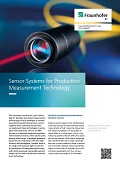The opto-mechanical integration of the sensors uses compact, robust measuring heads connected to the interferometric evaluation unit via fiber optic cables up to 50 m in length. The measuring radiation is emitted from the measuring head toward the object surface and from there scattered back in the direction of the measuring head. This bidirectional (bd for short) beam guidance requires very little space for the sensor integration in systems and production lines. In laser processing systems, such sensors are advantageous because their measuring radiation can be coaxially superimposed on the processing laser beam and guided via a focusing optical system already present on the process side. This way, distance measurements can be made directly where the processing occurs.
Geometry features such as step heights, hole depths, weld penetration depths, surface topographies and also spatially resolved layer thickness and 3D tomography images can be generated from 1D distance measurements when the measured object is moved or the measuring beam deflected, e. g., with a scanner mirror. The measurement signal quality is not significantly disturbed by measurements on glowing objects (e. g., glass, metal), by laser processing radiation or plasmas (e. g., in laser welding) or by metal powder (e. g., in Laser Material Deposition).
The Fraunhofer ILT‘s absolute measuring devices can be equipped with independent measuring heads for up to four measuring points. In a time-division multiplexing process, the usable measuring frequency of, for example, 80 kHz (»bd-1«) is divided into two measuring points with 40 kHz each (»bd-2«) or into four measuring points with 20 kHz each (»bd-4«). In addition to the equal splitting of the measuring frequencies, asymmetrical splitting is also possible, such as 90 percent of the measurements at measuring point 1 and 10 percent at measuring point 2. For sensor arrangements requiring several measuring points, this splitting significantly reduces the total costs – by about two thirds.
Available light sources and wavelengths The measuring wavelength most commonly used by Fraunhofer ILT for absolute measurements is 850 nm since the corresponding radiation can be detected with inexpensive CCD or CMOS sensors. In addition to measuring distance to surfaces, this wavelength can also be used for layer thickness and for tomography measurements on transparent objects such as glasses and plastics.
Furthermore, sensors with measuring wavelengths of 1064 nm and 1550 nm have been developed to meet application-specific requirements. For these wavelengths, however, comparatively expensive InGaAs sensors are needed to detect the measuring radiation.
Quantum light sources for the generation of entangled photon pairs are also the subject of research and development at Fraunhofer ILT. Here, photons in the mid-infrared (MIR) are generated to scan objects to be measured, and then transfer their measurement information to entangled photons in the easily detectable visible (VIS) or near-infrared (NIR) wavelength range. This makes the MIR wavelength range from 2 μm to 10 μm accessible to production measurement technology for the first time. Long-wavelength measurement radiation is advantageous, for example, for coating thickness and tomography measurements on objects such as ceramics, colored plastics or foams. These scatter strongly in the VIS and NIR range, but show almost no scattering in the MIR range so that greater optical penetration depths can be achieved.

 Fraunhofer Institute for Laser Technology ILT
Fraunhofer Institute for Laser Technology ILT